
Balancing Acts ~ Geranium Essential Oil, Irene Griffin
The iconic geranium essential oil is favoured by many because of its beautiful memorable scent, often used to comfort and soothe the mind. Yet there’s a little confusion around the real source of this aromatherapy treasure…

Image: Allgau
This popular essential oil is actually derived from the Pelargonium genus and not from the Geranium genus of the Geraniaceae species. To be clear, there are three definitive types of Geraniaceae family plants.
- Geranium, (Cranesbill or True Geraniums – 422 species)
- Pelargonium, (280 species)
- Erodium, (80 species)
Interestingly, the origin of these three genera names are from the Greek words for three birds as the seed heads the have the same characteristics which resemble their long beaks, the Crane – Geranium, (geranos), the Stork – Pelargonium, (pelargos), and the Heron – Erodium (erodios).

Image: Kenraiz
There are distinct physical differences in each of the species with the traditional garden and pot plants we refer to as ‘Geraniums’ also actually being ‘Pelargoniums’ – recognisable by their round palmate leaves and long-stalked ‘pom-pom’ flower heads. These ubiquitous plants are not the source of the oil, in fact they have a deep earthy scent that is not in the least similar to the essential oil.

Image: Starr
Instead, it is the plant that we know as ‘lemon-scented geranium’, (Pelargonium graveolens), with its hairy, deeply lobed leaves, small pink flowers and unmistakable ‘scratch & sniff’ lemon scent, that is the Pelargonium, originating in South Africa, from which the oil is extracted. To add another layer of complexity to this tale, the oil is either sold as the more popular ‘Geranium Bourbon’, (Pelargonium graveolens) or the rarer ‘Rose Geranium’, (Pelargonium x asperum) but which oil is the right one? At The School for Aromatic Studies, Jade Shutes does a deep dive into this question to explore the truth of the matter.

בנצי :Image
Plant taxonomy addressed, the aromatherapeutic elements of geranium are most definitely worthy of a second look. All essential oils are made up of a combination of chemical compounds – a bit like a jigsaw puzzle of molecular constituents. They all have different properties and subsequently potential effects on the body and the mind. Some compounds are stimulating, while others are sedating etc and depending on which particular compounds the oil contains and in which quantities, the ‘symbiotic’ or overall combination will define the actions of the oil. Here’s where geranium gets interesting.

Image: Leyo
Comprised of a mixture of compounds which are both calming and stimulating in almost equal percentages, geranium can be referred to as a ‘balancing’ essential oil, often indicated when feeling ‘off centre’. Presenting distinct floral notes alongside this balancing effect, it can often be indicated as specifically beneficial for females – which can be attributed to research suggesting that it has oestrogenic properties, therefore useful for addressing menopausal symptoms and menstrual-related hormonal fluctuations.* However, the uplifting yet serene properties of this wonderful oil do not discriminate by gender, instead, offer a universal appeal to all.

Image: E-codices
When I think of the aroma of Geranium oil, I am immediately transported to a heavenly ‘Turkish Delight’ plateau where my olfactory senses are enveloped by complex rosy florals meeting a sherbet lemon edge. I find the notes that geranium sings are soft and round but possess a lingering force that will gently permeate the ambience and hold their complete aromatic presence without really altering as they eventually fade. Ultimately, for me, geranium is a fundamental element of my practitioner oils for both men and women alike. It remains a go-to ingredient in my own personal hormone balance blend and never fails to literally ‘round off’ any sharp emotional edges I may experience. The magic carpet ride of geranium generously gives and continues to give…

Image: Senet
*(It is important to note from a clinical practice safe-use perspective, that as geranium oil is indicated by research as being an ‘oestrogenic’ oil, it is not recommended for use by anyone with an oestrogen-dependent cancer condition.)
